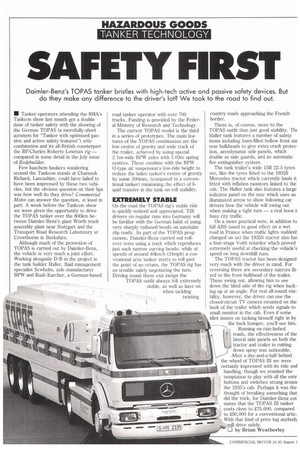SAFETY FIRST
Page 42

If you've noticed an error in this article please click here to report it so we can fix it.
• Tanker operators attending the RHA's Tankcon show last month got a double dose of tanker safety with the showing of the German TOPAS (a mercifully-short acronym for "Tanker with optimised passive and active safety features") artic combination and its all-British counterpart the BP/Charles Roberts Lowtnax rig — compared in some detail in the July issue of Bodybuilder.
Few hazchem hauliers wandering around the Tankcon stands at Charnock Richard, Lancashire, could have failed to have been impressed by these two vehicles, but the obvious question on their lips was how well do they drive? Commercial Motor can answer the question, at least in part. A week before the Tankcon show we were given the opportunity to drive the TOPAS tanker over the 800krn between Daimler-Benz's giant Worth truck assembly plant near Stuttgart and the Transport Road Research Laboratory at Crowthorne in Berkshire.
Although much of the promotion of TOPAS is carried out by Daimler-Benz, the vehicle is very much a joint effort. Working alongside D-B in the project is the tank builder Haller, fluid management specialist Scwhelm, axle manufacturer BPW and Raab Karcher, a German-based road tanker operator with over 700 trucks. Funding is provided by the Federal Ministry of Research and Technology.
The current TOPAS model is the third in a series of prototypes. The main features of the TOPAS combination are the low centre of gravity and wide track of the trailer, achieved by using special 2.1m-wide BPW axles with 1.03m spring centres. These combine with the BPW 0-type air suspension's low-ride height to reduce the Laden tanker's centre of gravity by some 300mm, (compared to a conventional tanker) minimising the effect of liquid transfer in the tank on roll stability.
On the road the TOPAS rig's stable ride is quickly noticed and appreciated. TIR drivers on regular runs into Germany will be familiar with the German habit of using very sharply radiused bends on autobahn slip roads. As part of the TOPAS programme, Daimler-Benz carried out rollover tests using a track which reproduces just such narrow curving bends: while at speeds of around 40krtai (24mph) a conventional artic tanker starts to roll past the point of no return, the TOPAS rig has no trouble safely negotiating the turn. Driving round these exit ramps the TOPAS outfit always felt extremely stable, as well as later on country roads approaching the French border_ There is, of course, more to the TOPAS outfit than just good stability. Th( Haller tank features a number of safety items including foam-filled hollow front an( rear bulkheads to give extra crash protection, aerodynamic side panels, which double as side guards, and an automatic fire extinguisher system.
The tank trailer's wide 15R 22.5 tyres are, like the tyres fitted to the 1935S Mercedes tractor which currently hauls it. fitted with inflation monitors linked to the cab. The Haller tank also features a large indicator panel on the rear which uses an illuminated arrow to show following car drivers how the Vehicle will swing out when making a tight turn — a real boon ii busy city traffic.
On a more practical note, in addition to full ABS (used to good effect on a wet road in France when traffic fights suddenk changed on us) the 19355 tractor also has a four-stage Voith retarder which proved extremely useful at checking the vehicle's speed on long downhill runs.
The TOPAS tractor has been designed very much with the driver in mind. For reversing there are secondary mirrors fitted to the front bulkhead of the trailer. These swing out, allowing him to see down the blind side of the rig when backing up at an angle. For real all-round visibility, however, the driver can use the closed-circuit TV camera mounted on the back of the trailer which sends signals to small monitor in the cab. Even if some idiot insists on tucking himself right in by the back bumper, you'll see him_
• ---N, 1 Running on rain-lashed tl roads, the effectiveness of the ° 1 lateral side panels on both the
tractor and trailer in cutting — down spray was noticeable. After a day-and-a-half behind the wheel of TOPAS III we were certainly impressed with its ride and handling, though we resisted the temptation to play with all the extr buttons and switches strung arount the 1935's cab. Perhaps it was the thought of breaking something that did the trick, for Daimler-Benz est mates that the TOPAS III tanker costs close to £75,000, compared , to £50,000 for a conventional artic.
With that kind of price tag anybody will drive safely.




































































































